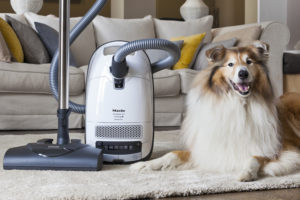
If you’re following carpet trends, you might have heard the word “griege” lately. In most cases, it’ll have to do with one of two elements: color or fiber. Today we’ll look at both griege as a color in finished carpets and as a term for unfinished carpet fibers. We’ll also examine the benefits and drawbacks to choosing griege as a carpet color, and whether the unfinished fiber definition has any bearing on the kind of carpet you choose for your living space.
Griege as a carpet color – grey and beige

The first and more common definition of griege among carpet buyers is tied to color: it’s basically a hue of gray or brown, depending on where you’re starting from. Most people call it a combination of biege and gray, and in the last few years, it’s quickly become a “must have” color when decorating interiors. Like taupes and tans, people who like it do so because of it’s calming, soothing nature, as well as because it’s highly compatible with just about any décor.
If you search on the Internet for griege carpet, you’ll see a range of carpet styles with the same warm gray color. Similarly, if you visit carpet retailers and request a griege carpet, you’re going to get swatches of tans and taupes, because those are in the same color family. However, if you visit a carpet manufacturer, griege goods won’t quite have to do with the color, but with the condition of the carpet fiber.
What are griege goods and how are they related to carpet fibers?

In the carpet making industry, griege goods are partially made synthetic carpet fibers; the fibers have been spun but they haven’t had color added to them. Color can be added two ways: while the fibers are made, which is known as solution dyeing, or after fibers have been made, which is called traditional, beck, or piece dyeing. Solution dyeing is the better of the two approaches when it comes to stain resistance, as the dye is mixed with the liquid chemicals that will become the carpet fibers before they’ve dried into fibers. With griege fibers, in contrast, the fibers are made without color and called griege goods because the color is, well, a blend of gray and beige, or in common parlance, griege. Once the fibers have been made, the colors can then be added in a range of ways that fundamentally involve dipping the carpet fibers in various mixtures of liquid dye to achieve the target color.
Why choose griege goods?

The advantage of griege goods is primarily on the carpet manfuacturer’s end; when they start with a griege-colored carpet fiber, they have a lot more flexibility over the end color, as they can choose from millions of dye combinations to meet customer needs. They also have a much greater advantage in delivery times, as they can make griege fibers in bulk and simply dye them to customer specifications as needed. Solution-dyed fibers, in contrast, must be decided upon far in advance, and if there isn’t enough demand later on for specific colors, that carpet fiber can sit in inventory for months or years if not resold or discounted. For example, if dark colors go out of style and a manufacturer solution-dyed a lot of black and blue carpets, they’re going to end up sitting in a warehouse unsold while the manufacturers scramble to meet whatever’s trendy.
What are the disadvantages of griege goods?

From your perspective as a buyer, carpets made from griege goods are faster to order for the reasons outlined above, and you’re also going to have a wider range of colors available to you. However, the convenience comes at a cost: carpets that have been solution-dyed are far more vulnerable to staining and soiling (whether from beer, wine, orange juice, coffee, or cat and dog urine) than solution-dyed carpets since they have empty dye sites where the coloring never reached on a microscopic level.
In the end, if you’re shopping for a residential carpet, you’re not going to need to worry so much about griege goods; just focus on the style you like (e.g., a Saxony, berber, frieze, or cut and loop), the pile you prefer (e.g., low, medium, or high), and the fiber choice (e.g., synthetic or natural). If you want it to be griege, that’s fine too.
Do you recommend special vacuum cleaners for griege carpets?

Additional good news is that you don’t need to choose a special vacuum for griege-colored or griege-good carpets vs. any other color or dyeing method. What really matters when choosing a vacuum for carpeting is a.) that it can clean the styles and piles you’re interested in, and b.) that it can do so for a long time.
To be able to clean any style and pile of carpet without hesitation, we always recommend vacuums with powered electric brush heads. As a bonus, it’s nice for them to have Parquet heads as well to make quick work of hardwood and other bare floors you might have in your home (e.g., in the kitchen and bathroom, if nowhere else). Our standard recommendations for buy-it-for-life vacuums that have both cleaning heads are the Miele Complete C3 Cat & Dog (reviewed here and here) and Miele Compact C2 Electro+ (reviewed here and here). Both are powerful, well-designed, and made from workers with living wages in Germany, increasing their odds of meeting Miele’s 20+ year estimates of flaw-free usability.
![]() You can buy the Miele Complete C3 Cat & Dog here on Amazon or buy the Miele Compact C2 Electro+ here.
You can buy the Miele Complete C3 Cat & Dog here on Amazon or buy the Miele Compact C2 Electro+ here.
![]() Canadians can buy the Miele C3 Cat & Dog here or buy the Compact Electro+ here.
Canadians can buy the Miele C3 Cat & Dog here or buy the Compact Electro+ here.
 If you find our research on PMC helpful, you can follow our efforts to keep maniacally reviewing home cleaning tools by shopping through our links above. We promise to keep fighting the good fight against every horror children, animals, and grown, yet messy humans can inflict upon a clean home.
If you find our research on PMC helpful, you can follow our efforts to keep maniacally reviewing home cleaning tools by shopping through our links above. We promise to keep fighting the good fight against every horror children, animals, and grown, yet messy humans can inflict upon a clean home.

